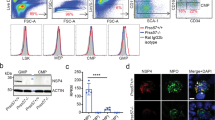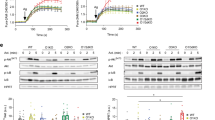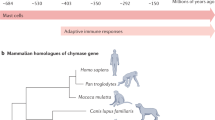Abstract
Heparin is a sulphated polysaccharide, synthesized exclusively by connective-tissue-type mast cells1 and stored in the secretory granules in complex with histamine and various mast-cell proteases2. Although heparin has long been used as an antithrombotic drug, endogenous heparin is not present in the blood, so it cannot have a physiological role in regulating blood coagulation. The biosynthesis of heparin involves a series of enzymatic reactions, including sulphation at various positions1,3. The initial modification step, catalysed by the enzyme glucosaminyl N -deacetylase/N -sulphotransferase-2, NDST-2 (4–7), is essential for the subsequent reactions. Here we report that mice carrying a targeted disruption of the gene encoding NDST-2 are unable to synthesize sulphated heparin. These NDST-2-deficient mice are viable and fertile but have fewer connective-tissue-type mast cells; these cells have an altered morphology and contain severely reduced amounts of histamine and mast-cell proteases. Our results indicate that one site of physiological action for heparin could be inside connective-tissue-type mast cells, where its absence results in severe defects in the secretory granules.
This is a preview of subscription content, access via your institution
Access options
Subscribe to this journal
Receive 51 print issues and online access
$199.00 per year
only $3.90 per issue
Buy this article
- Purchase on Springer Link
- Instant access to full article PDF
Prices may be subject to local taxes which are calculated during checkout




Similar content being viewed by others
References
Kjellén, L. & Lindahl, U. Proteoglycans: Structure and interactions. Annu. Rev. Biochem. 60, 443–475 (1991).
Stevens, R. L. & Austen, K. F. Recent advances in the cellular and molecular biology of mast cells. Immunol. Today 10, 381–386 (1989).
Lindahl, U., Kusche-Gullberg, M. & Kjellén, L. Regulated diversity of heparan sulfate. J. Biol. Chem. 273, 24979–24982 (1998).
Pettersson, I. et al. Biosynthesis of heparin: Purification of a 110?kDa mouse mastrocytoma protein required for both glucosaminyl N-deacetylation and N-sulfation. J. Biol. Chem. 266, 8044–8049 (1991).
Orellana, A., Hirschberg, C. B., Wei, Z., Swiedler, S. J. & Ishihara, M. Molecular cloning and expression of a glycosaminoglycan N-acetylglucosaminyl N-deacetylase/N-sulfotransferase from a heparin-producing cell line. J. Biol. Chem. 269, 2270–2276 (1994).
Eriksson, I., Sandbäck, D., Ek, B., Lindahl, U. & Kjellén, L. cDNA cloning and sequencing of mouse mastocytoma glucosaminyl N-deacetylase/N-sulfotransferase. J. Biol. Chem. 269, 10438–10443 (1994).
Kusche-Gullberg, M., Eriksson, I., Sandbäck-Pikas, D. & Kjellén, L. Identification and expression in mouse of two heparan sulfate glucosaminyl N-deacetylase/N-sulfotransferase genes. J. Biol. Chem. 273, 11902–11907 (1998).
Toma, L., Berninsone, P. & Hirschberg, C. B. The putative heparin-specific N-acetylglucosaminyl N-deacetylase/N-sulfotransferase also occurs in non-heparin-producing cells. J. Biol. Chem. 273, 22458–22465 (1998).
Hashimoto, Y., Orellana, A., Gil, G. & Hirschberg, C. B. Molecular cloning and expression of rat liver N-heparan sulfate sulfotransferase. J. Biol. Chem. 267, 15744–15750 (1992).
Aikawa, J-i. & Esko, J. D. Molecular cloning and expression of a third member of the heparan sulfate/heparin GlcNAc N-deacetylase/N-sulfotransferase family. J. Biol. Chem. 274, 2690–2695 (1999).
Lindahl, U., Lidholt, K., Spillman, D. & Kjellén, L. More to “heparin” than anticoagulation. Thromb. Res. 75, 1–32 (1994).
Salmivirta, M., Lidholt, K. & Lindahl, U. Heparan sulfate: A piece of information. FASEB J. 10, 1270–1279 (1996).
Rosenberg, R. D., Shworak, N. W., Liu, J., Schwartz, J. J. & Zhang, L. Heparan sulfate proteoglycans of the cardiovascular system. Specific structures emerge but how is synthesis regulated? J. Clin. Invest. 99, 2062–2070 (1997).
Bullock, S. L., Fletcher, J. M., Beddington, R. S. P. & Wilson, V. A. Renal agenesis in mice homozygous for a gene trap mutation in the gene encoding heparan sulfate 2-sulfotransferase. Genes Dev. 12, 1894–1905 (1998).
Binari, R. C. et al. Genetic evidence that heparin-like glycosaminoglycans are involved in wingless signaling. Development 124, 2623–2632 (1997).
Haerry, T. E., Heslip, T. R., Marsch, J. L. & O'Connor, M. O. Defects in glucuronate biosynthesis disrupt Wingless signalling in Drosophila. Development 124, 3055–3064 (1997).
Häcker, U., Lin, X. & Perrimon, N. The Drosophila sugarless gene modulates Wingless signaling and encodes an enzyme involved in polysaccharide biosynthesis. Development 124, 3565–3573 (1997).
Huang, C., Sali, A. & Stevens, R. L. Regulation and function of mast cell proteases in inflammation. J. Clin. Immunol. 18, 169–183 (1998).
Lützelschwab, C., Pejler, G., Aveskogh, M. & Hellman, L. Secretory granule proteases in rat mast cells. Cloning of 10 different serine proteases and carboxypeptidase A from various rat mast cell populations. J. Exp. Med. 185, 13–29 (1997).
Kusche, M., Lindahl, U., Enerbäck, L. & Rodén, L. Identification of oversulphated and galactosaminoglycans in intestinal-mucosal mast cells of rats infected with the nematode worm Nippostrongylus brasiliensis. Biochem. J. 253, 885–893 (1988).
Galli, S. J. & Wershil, B. K. The two faces of the mast cell. Nature 381, 21–22 (1996).
Fässler, R. & Meyer, M. Consequences of lack of β-1 integrin gene expression in mice. Genes Dev. 9, 1896–1908 (1995).
Nagy, A., Rossant, J., Nagy, R., Abramow-Newerly, W. & Roder, J. C. Derivation of completely cell culture-derived mice from early-passage embryonic stem cells. Proc. Natl Acad. Sci. USA 90, 8424–8428 (1993).
Cheung, W.-F., Eriksson, I., Kusche-Gullberg, M., Lindahl, U. & Kjellén, L. Expression of mouse mastocytoma glucosaminyl N-deacetylase/N-sulfotransferase in human kidney 293 cells results in increased N-sulfation of heparan sulfate. Biochemistry 35, 5250–5256 (1996).
Lützelschwab, C., Huang, M. R., Kullberg, M. C., Aveskogh, M. & Hellman, L. Characterization of mouse mast cell protease-8, the first member of a novel subfamily of mouse mast cell serine proteases, distinct from both the classical chymases and tryptases. Eur. J. Immunol. 28, 1022–1033 (1998).
Acknowledgements
We thank A. Nagy for R1 ES cells, and P. Ekblom and U. Lindahl for helpful suggestions and support. This work was supported by grants from the Swedish Natural Science Research Council, the Swedish Medical Research Council, the European commission, Polysackaridforskning AB, Gustaf V:s 80-årsfond, Magnus Bergvalls stiftelse, Wibergs stiftelse and Stiftelsen Lars Hiertas minne. E.F. is a member of Uppsala University Transgenic Facility, supported by the Swedish Foundation for Strategic Research.
Author information
Authors and Affiliations
Corresponding author
Rights and permissions
About this article
Cite this article
Forsberg, E., Pejler, G., Ringvall, M. et al. Abnormal mast cells in mice deficient in a heparin-synthesizing enzyme. Nature 400, 773–776 (1999). https://doi.org/10.1038/23488
Received:
Accepted:
Issue Date:
DOI: https://doi.org/10.1038/23488
This article is cited by
-
Proteoglycan serglycin promotes non-small cell lung cancer cell migration through the interaction of its glycosaminoglycans with CD44
Journal of Biomedical Science (2020)
-
Neutrophil serine protease 4 is required for mast cell-dependent vascular leakage
Communications Biology (2020)
-
A mutant-cell library for systematic analysis of heparan sulfate structure–function relationships
Nature Methods (2018)
-
SLC10A4 regulates IgE-mediated mast cell degranulation in vitro and mast cell-mediated reactions in vivo
Scientific Reports (2017)
-
Acidic pH is essential for maintaining mast cell secretory granule homeostasis
Cell Death & Disease (2017)
Comments
By submitting a comment you agree to abide by our Terms and Community Guidelines. If you find something abusive or that does not comply with our terms or guidelines please flag it as inappropriate.



